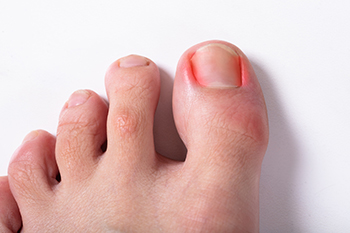
An ingrown toenail is easy to notice. The side of the toenail grows into the skin instead of over it. It can be quite uncomfortable, and in severe cases, may bleed, and become infected. It can happen for a variety of reasons, such as wearing shoes that do not have enough room in the toe area, having endured a toe injury, or from trimming the toenails improperly. Genetic reasons may contribute to getting an ingrown toenail, and this may account for people who naturally have curved toenails, or have toenails that are too large for their toes. Common symptoms that are associated with ingrown toenails include redness, swelling, and pain. The affected toe may temporarily feel better when it is soaked in warm water, which can soften the nail. This may make it easier to pull the skin away from the toe, despite the fact it may not last. If you have an ingrown toenail, there is a chance it can become infected, and it is strongly advised that you consult with a podiatrist as quickly as possible who can offer professional treatment.
Ingrown toenails can become painful if they are not treated properly. For more information about ingrown toenails, contact Dr. Joshua David Scoll of Pennsylvania. Our doctor can provide the care you need to keep you pain-free and on your feet.
Ingrown Toenails
Ingrown toenails occur when a toenail grows sideways into the bed of the nail, causing pain, swelling, and possibly infection.
Causes
- Bacterial infections
- Improper nail cutting such as cutting it too short or not straight across
- Trauma to the toe, such as stubbing, which causes the nail to grow back irregularly
- Ill-fitting shoes that bunch the toes too close together
- Genetic predisposition
Prevention
Because ingrown toenails are not something found outside of shoe-wearing cultures, going barefoot as often as possible will decrease the likeliness of developing ingrown toenails. Wearing proper fitting shoes and using proper cutting techniques will also help decrease your risk of developing ingrown toenails.
Treatment
Ingrown toenails are a very treatable foot condition. In minor cases, soaking the affected area in salt or antibacterial soaps will not only help with the ingrown nail itself, but also help prevent any infections from occurring. In more severe cases, surgery is an option. In either case, speaking to your podiatrist about this condition will help you get a better understanding of specific treatment options that are right for you.
If you have any questions please feel free to contact one of our offices located in Philadelphia and Bensalem, PA . We offer the newest diagnostic and treatment technologies for all your foot and ankle needs.

